
Original Link: https://www.anandtech.com/show/1794
ATI's Avivo Platform - H.264 Decode and Transcode Acceleration on R5xx
by Anand Lal Shimpi on September 20, 2005 10:44 AM EST- Posted in
- GPUs
Over two years ago, Intel introduced the world to their first platform brand - Centrino. And just at this past IDF, Intel announced their second platform brand - Viiv. Both Centrino and Viiv had their reasons for being created; they had their overall goals. Centrino was brought forth to improve the mobile platform by extending battery life and make wireless networking ubiquitous. Intel's Viiv was created to address the growing segment of users interested in media PCs, to improve the overall media experience on the PC through better performance, more CE-like operation, and guaranteed connectivity to CE devices. It is also tough to ignore the fact that Centrino and shortly, Viiv, were both created to be tremendously profitable and keep the competition away from the pie.
Like school children, technology companies are very easily influenced by one another. Intel kicked off their Centrino brand in March of 2003 and made it highly successful, exciting envy and a desire to attain the same in competitors and other tech companies around the globe. AMD tried their hand at platform branding with the Turion 64 mobile platform, and today, we're here to talk about ATI's first video platform - Avivo.
Much like Intel's Centrino and Viiv, Avivo is a reference to a platform, and as such, it doesn't refer to just one product, but in this case, two. A complete Avivo platform features an Avivo capture card, and an Avivo graphics card. As of today, the only Avivo capture card available is the ATI Theater 550, and presently, there are no Avivo graphics cards available. The next-generation of GPUs from ATI (R520, RV530 and RV515) will all support Avivo, and thus, they make up the second half of the platform.
What is Avivo's reason for existing? According to ATI, Avivo exists to address the future of displaying digital pictures and video on the PC, and to put it more succinctly, it strives to perfect the "Video Pipeline". So, while Intel's Centrino focused on perfecting mobility, and Viiv will attempt to perfect the media center PC, Avivo aims to do the same for the capture, encoding, decoding, processing and display of video. ATI calls these five areas that Avivo will improve: stages of the "video pipeline".

Avivo Improves Video Capture
Avivo doesn't actually bring anything new to the table when addressing the video capture stage of the video pipeline. Instead, it simply uses a product that's been in existence for a while now - ATI's Theater 550.
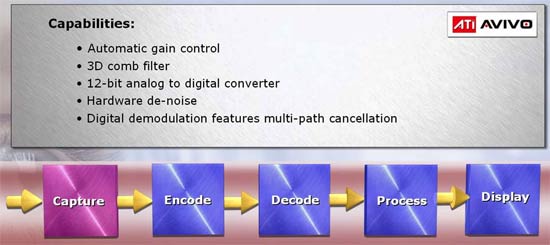
GPU Accelerated H.264 Transcode
The two stages of the video pipeline to which Avivo pays particular attention are the encode and decode stages. Of course, with the Theater 550, ATI already offers hardware MPEG-2 based encoding, so that is not really a new feature of the Avivo platform. The more interesting feature is the "VPU assisted transcode" that is now a part of Avivo.
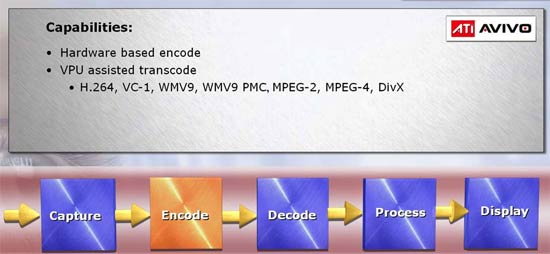
All Avivo enabled graphics cards will support this GPU assisted transcode; the only requirement will be that the appropriate Catalyst driver is installed. While ATI is currently planning to release the first of their R5xx GPUs by the end of this month, the transcode acceleration will not be ready by that time. ATI has committed to delivering the transcode acceleration by the end of this year, and more specifically, about a month after the release of the R5xx GPUs. We have no word as to how much of a performance boost you'll see with the GPU assisted transcode, although the largest gains will be going from formats like MPEG-2 to something like H.264. (The reason being that H.264 encoding is incredibly slow using CPU-only encoding right now.)
GPU Accelerated H.264 Decode
Transcode acceleration isn't the only thing that the R5xx GPUs will be doing; as we saw at Computex, ATI has had working H.264 decode acceleration for months now, and it will be a requirement for all Avivo platforms.
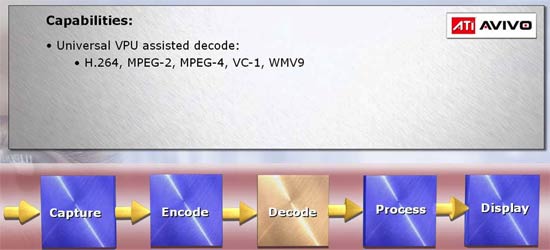
Keep in mind that we're still talking about GPU assisted decode, so there are still a lot of functions that are done by the CPU. Avivo GPUs will perform in-loop deblocking, motion compensation and inverse transform.

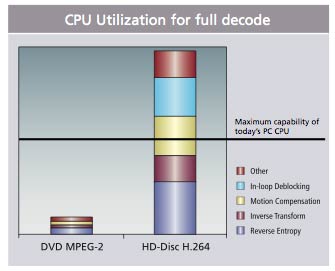
The H.264 decode acceleration of Avivo GPUs is quite important, mostly because both the next-generation DVD standards (HD-DVD and Blu-ray) will both use H.264 as the encoding format for video stored on the discs.
For what it's worth, NVIDIA has committed to delivering H.264 decode acceleration later this year on their GeForce 7 based products; but we have yet to see a live demo of the technology.
Improved De-Interlacing and Video Scaling
With Avivo, ATI has also improved their de-interlacing and video scaling, both of which are important features for any media PC.
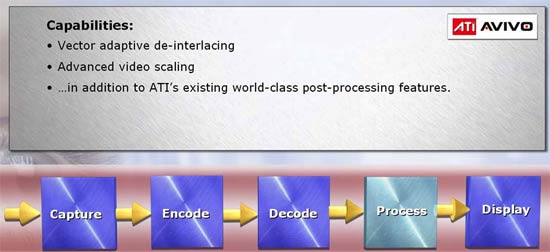
Although we saw pictures of ATI's new de-interlacing in action, we cannot at present really determine its quality. The same can be said about the new scaler in ATI's upcoming hardware: we're just going to have to wait and see. For now, all we can say is that it appears better than what was in the R4xx series of GPUs.
Improved Connectivity
The final message of Avivo, once again delivered through the R5xx GPUs, is one of improved connectivity.
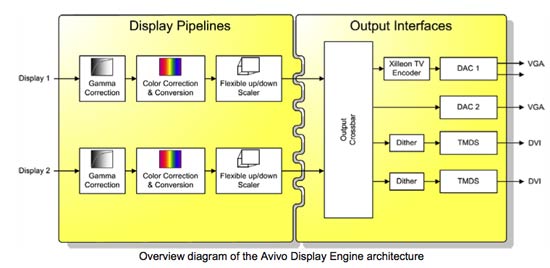
Avivo also improves the quality of the TV output on graphics cards by using ATI's Xilleon TV encoder that is found in many of today's televisions. Once again, we'll have to wait and see exactly how the quality measures up to the competitors, but it should be a step in the right direction for improving TV output quality.
The other major improvement that Avivo graphics cards will offer is a 10-bit display pipeline, so that each color component during gamma correction, color correction, scaling and dithering has a minimum of 10-bits of precision.
Matrox was the first consumer vendor to introduce a 10-bit display pipeline, which they called 10-bit GigaColor in their Parhelia line of graphics cards. ATI is obviously later to the game, but it is better late than never. We've already discussed the benefits of a 10-bit display engine in our Parhelia review.
Final Words
Although ATI's announcement today kicks off Avivo, we really won't get a good feel for what the platform can really do until ATI finally launches their R5xx GPUs. ATI is saying that the first Avivo enabled GPUs should be shipping by the end of this month, meaning that the first R5xx GPUs should be available by then. Once we have hardware in-house, we can really put Avivo to the test.
At this point, we're mostly excited about the GPU assisted transcode and decode features of the R5xx series of GPUs, and even more excited that both features are supposed to be available by the end of this year. As we get more information on release dates and product offerings, we will of course keep you updated.







